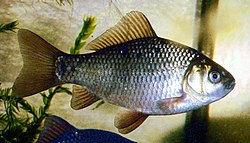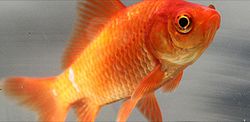| Carassius | |
|---|---|
 | |
| Crucian carp, Carassius carassius | |
 | |
| Goldfish, Carassius auratus | |
| Scientific classification | |
| Kingdom: | Animalia |
| Phylum: | Chordata |
| Class: | Actinopterygii |
| Order: | Cypriniformes |
| Family: | Cyprinidae |
| Subfamily: | Cyprininae |
| Genus: | Carassius Jarocki, 1822 [1] |
| Type species | |
| Carassius carassius | |
| Synonyms [1] | |
Carassius is a genus in the ray-finned fish family Cyprinidae. Most species in this genus are commonly known as crucian carps , though that term often refers specifically to C. carassius . The most well known species is the goldfish (C. auratus). They have a Eurasian distribution, apparently originating further to the west than the typical carps (Cyprinus genus, which includes the common carp).
The genus may not be monophyletic, with molecular phylogenetics finding that the genus Carassiodes is nested within Carassius; that clade is in turn sister to the typical carps in the genus Cyprinus. [2]